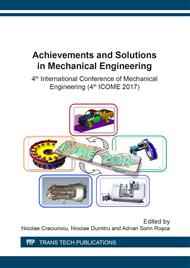p.183
p.189
p.195
p.201
p.207
p.213
p.220
p.226
p.235
Study on Improving the Ride Comfort in Railway Vehicles Using Anti-Bending Dampers
Abstract:
The paper researches the possibility to reduce the bending vibrations in the railway vehicle carbody and to improve the ride comfort via a new passive type method. This would involve the fitting of the vehicle with dampers, called anti-bending dampers, fixed to the longitudinal beams of a carbody underframe. The efficiency of this method is made visible in the results derived from numerical simulations developed on the basis of a rigid-flexible coupled vehicle model. The introduction of the anti-bending dampers is seen as a significant reduction in the bending vibration of the carbody. Similarly, a relevant improvement of the ride comfort at the centre of the carbody, at high velocities. This efficiency mainly depends on the damping constant of the anti-bending damper.
Info:
Periodical:
Pages:
207-212
Citation:
Online since:
March 2018
Authors:
Price:
Сopyright:
© 2018 Trans Tech Publications Ltd. All Rights Reserved
Share:
Citation:


